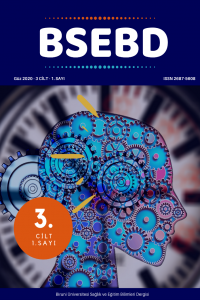DİL EDİNİMİ VE EDEBİYAT: EDEBİYAT DERSLERİNDE ANLAŞILIR GİRDİ
Bu çalışma, İngilizce edebiyat derslerinde anlaşılır girdinin rolüne özel olarak odaklanarak, İkinci Dil Edinimi (SLA) ile edebiyat arasındaki simbiyotik ilişkiyi araştırır. Stephen Krashen’in Input Hipotezi ile ifade edildiği şekliyle SLA teorisi, dil öğrenenlerin ikinci bir dili en etkili şekilde, mevcut yeterlilik seviyelerinin biraz üzerinde ve hala anlaşılabilir bir girdiye maruz kaldıklarında etkili bir şekilde edinimin gerçekleşebileceğini ileri sürer. Edebiyat dersleri bağlamında bu teori uygun ve sağlam bir zemin bulabilir. Öğrenciler edebi eserleri araştırdıkça, dilin çok yönlü ve çeşitli doğasını keşfederken dil yeterliliklerini de geliştirebilirler. Bu çalışma, dil edinimini kolaylaştırma aracı olarak edebiyat derslerinde anlaşılır girdilerin kritik rolünün altını çizmektedir. Bu çalışma, edebiyat derslerinde anlaşılabilir girdilerin dil edinimini kolaylaştırma açısından kritik bir rol oynadığını vurgulamaktadır. Ayrıca, çalışma edebiyatın bu süreçteki karşılıklı faydalarını da öne çıkararak, edebiyatın özgün dil kullanımı, kültürel anlayışlar ve eleştirel düşünme fırsatları sağlama gücünü ön plana çıkarmakta ve sonuç olarak öğrencilerin dil yeterliliklerini ve İngilizceye olan ilgilerini ikinci dil edinimi kuralları ile daha da verimli hale getirebileceği öne sürmektedir.
Anahtar Kelimeler:
SLA, Edebiyat, Dil, Krashen, Anlaşılır Girdi
LANGUAGE ACQUISITION AND LITERATURE: COMPREHENSIBLE INPUT IN LITERARY CLASSES
This study explores the symbiotic relationship between Second Language Acquisition (SLA) and literature, with a specific focus on the role of comprehensible input in English literary classes. SLA theory, as articulated by Stephen Krashen’s Input Hypothesis, posits that language learners acquire a second language most effectively when they are exposed to input that is slightly above their current proficiency level while still remaining comprehensible. In the context of literature classes, this theory can find a valuable application and a solid ground. As students delve into literary works, they can improve their language proficiency while exploring the multifaceted and diversified nature of the language. This study underscores the critical role of comprehensible input in English literary classes as a means to facilitate language acquisition. It further highlights the reciprocal benefits of literature in the process, emphasizing the power of literature to provide authentic language use, cultural insights, and opportunities for critical thinking, ultimately enriching students’ language proficiency and appreciation for English language.
Keywords:
SLA, Literature, Language, Krashen, Comprehensible Input,
___
- Day, R. R. & Bamford, J. (1998). Extensive Reading in the Second Language Classroom. Cambridge: Cambridge University Press.
- Faltis, C. (1984). ‘A Commentary on Krashen’s Input Hypothesis’. TESOL Quarterly 18(2) pp. 352-357.
- Gregg, K. R. (1984). ‘Krashen’s Monitor and Occam’s Razor’. Applied Linguistics 5(2) pp. 79-100.
- Hafiz, F. M. & Tudor, I. (1989). ‘Extensive reading and the development of language skills’. ELT Journal 43(1) pp. 4-13.
- Krashen, S. D. (1982). Principles and Practice in Second Language Acquisition. Oxford: Pergamon.
- Krashen, S. D. &Terrell, T. D. (1983). The Natural Approach: Language Acquisition in the Classroom. Oxford: Pergamon Press.
- Krashen, S. D. (1985). The Input Hypothesis: Issues and Implications. London: Longman.
- Krashen, S. D. (1989). Language Acquisition and Language Education. London: Prentice Hall International.
- Krashen, S. (1993). The Power of Reading: Insights from the Research. Englewood: Libraries Unlimited.
- Lessing, D. (1988). The Fifth Child. London: Harper Perennial.
- Mclaughlin, B. (1987). Theories of Second Language Learning. London: Edward Arnold.
- Nuttall, C. (1982). Teaching Reading Skills in a Foreign Language. London: Heinemann.
- Renandya, W. A. (2007). ‘The Power of Extensive Reading’. SAGE Publications 38(2) pp. 133-149.
- Payne, M. (2011). ‘Exploring Stephen Krashen’s ‘i+1’ acquisition model in the classroom’. Linguistics and Education 22(4) pp. 419-429.
- Renandya, W. A. (2007). ‘The Power of Extensive Reading’. SAGE Publications 38(2) pp. 133-149.
- Renandya, W. A., & Jacobs, G. M. (2016). Extensive reading and listening in the L2 classroom. In W. A. Renandya, & Handoyo, P. (Eds.), English language teaching today (pp. 97-110). New York, NY: Routledge.
- White, L. (1987). ‘Against Comprehensible Input: the Input Hypothesis and the Development of Second Language Competence’. Applied Linguistics 8(2) pp. 95-110.
- ISSN: 2687-5608
- Başlangıç: 2017
- Yayıncı: Biruni Üniversitesi
